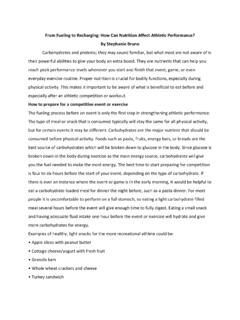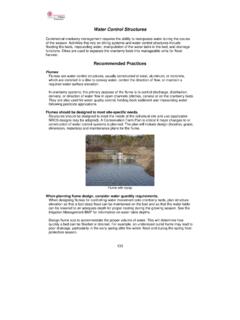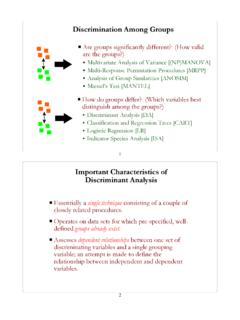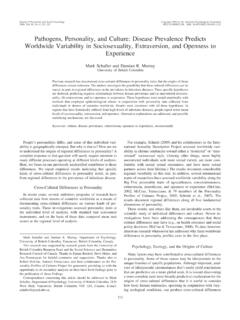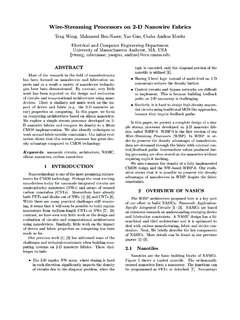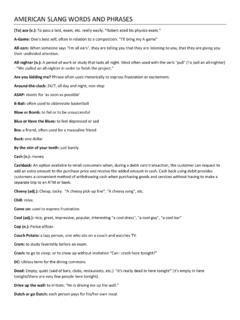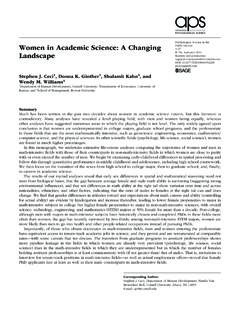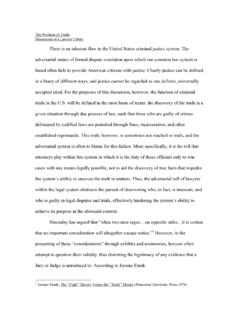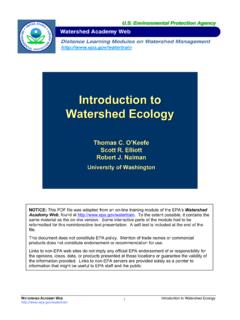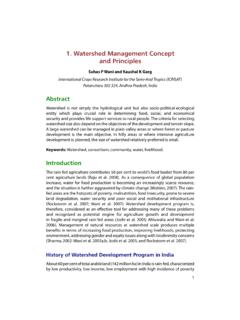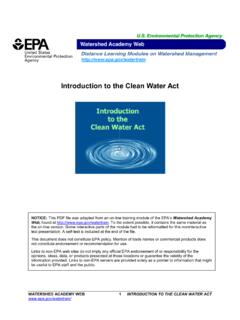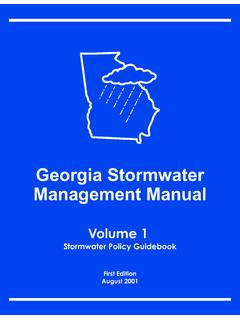Transcription of Data Interpretation Jerry Schoen Introduction
1 data Interpretation Page1 data InterpretationGeoff Dates, River Watch NetworkJerry Schoen , Massachusetts Water Watch PartnershipIntroductionTurning data into useful information is one step in your monitoring program. Yourprogram should begin with a clear study design, which describes the rationale and methodsfor your program. A part of the study design process is identifying the people who youexpect to use your data , how you expect them to use it, and what specific questions you'retrying to answer about the river. If you've geared your monitoring to the needs ofidentified data users and conducted your monitoring to answer specific questions aboutyour river, you'll find that this step is not as difficult as it might monitoring data into useful information a process that involves several steps:1) data Entry: This involves getting your raw data into a computer so that you canstore it and retrieve it for analysis.
2 It includes two steps:a. Entry: data should be entered into a computer data management Validation: The entered data must be checked against the field and lab sheetsto assure that it has been entered ) Summary: The data is put into a form that allows you to view it as a whole, suchas simple statistics, tables, and ) data Interpretation : This involves asking a series of questions about your datathat relate to your study question(s). Your answers to these questions are organized asfindings and conclusions. Based on these, you may develop recommendations for action orfurther ) Presenting Your Results: Present your findings, conclusions, and recommendationsin a form that best tells the story of your river. This story can be told in text and selectedtables and graphs that are organized into an oral presentation and/or a written presentation or report should be geared to the audience you are trying to paper focuses on the data Interpretation Interpretation Page2 data Interpretation :Interpreting your data is a process that involves answering a series of questions about suggest the following steps:1)Review and interpret the data "in-house" to develop preliminary findings,conclusions, and )Review the data and your Interpretation of it with an advisory group or technicalcommittee.
3 This group should involve local, regional, and state resource peoplewho are familiar with monitoring and with your river. They can verify, add to, orcorrect your Interpretation of the )Review the data and your Interpretation of it with the people who will use yourdata -- for example, the public, river users, and government officials. Ultimately, your Interpretation of the data relates back to the questions your monitoringprogram is trying to answer. For example, does the river met state water qualitystandards? Following are examples of questions you might answer at each step in order todevelop findings and conclusions that relate to your study are four steps to data Interpretation : 1) assemble the information you'll need, 2) develop findings, 3) develop conclusions, and 4) develop recommendations. Thefollowing sections describe each step. The sections on findings, conclusions, andrecommendations suggest questions you should answer at each 1: Assemble the Information You'll NeedMake sure that you have all the information that you will need for data information to have available include: a map of your watershed with the sites marked on it and the water qualityclassification of the segments you sampled.
4 Correct units of measurement clearly reported on your data tables and graphs. general observations, such as habitat and weather information for each samplingdate and site. the appropriate water quality standards or reference conditions for each indicator. historical or current information gathered from other water quality data sources,such as the state or other monitors, in a format similar to your might put all of these into easy-to-read tables, graphs, or maps to have availablewhen looking at your Interpretation Page3 When analyzing data it is important to keep in mind the following: The sensitivity of the methods and equipment you used. This will constrain whatyou can and can't say. For example, if you used a color wheel to determineorthophosphate concentration, you can't detect concentrations below mg/l.
5 So you shouldn't report these as "0." You should say that the results were"< mg/l". The degree of change that is important for each indicator. You may be able todetect some fairly small changes in the levels of indicators. Yet, these changes maynot be very important in terms of their impact on the river or this change is important depends on several the change compares with the natural or background levels of thatindicator in your water body. If natural levels are high (compared withtypical water bodies), it may take a relatively large change to affect theriver or the change compares with the natural variability of the indicator inyour water body. The level of most indicators varies naturally over timeand space. If the change you measure is within the range of this naturalvariability, it will probably not affect the river or the change crosses a threshold.
6 There are two types of thresholdsthat might be important: 1) the absolute level of an indicator, such that ifyour results fall above or below it, an impact results ( such as a level that iscritical for the survival of aquatic life), and 2) the magnitude of the change,for example, a change in temperature that causes stress in fish that aresensitive to changes. The degree of trust you have in the quality of the work done to obtain the the first sampling time, students might learn more about how to use theequipment and the procedures than they will about the actual river water is excellent information about the process of science, however, any data thatis the result of learning by trial and error should not be reported unless you areconfident that the procedures were not compromised. Alternatively, you can reportit if you note the problems which may have are examples of questions you might answer at each step in order to developfindings and conclusions that relate to your study Interpretation Page4 Step 2: Develop FindingsFindings are observations about your data .
7 They are the statements that summarize theimportant points. Findings will help you to come up with conclusions, because they helpyou form a more thorough and accurate Interpretation . We tend to look at data and beginto try to explain it before thoroughly observing and summarizing the trends, patterns orlack of patterns. Examples of findings are: Site number 3 violated water quality standards for dissolved oxygen on all days The number of benthic macroinvertebrates at all sites declined over the 3-yearperiod. Secchi depths were lowest in August at two of the three sites. Moving downstream, the amount of phosphorus increased on all days. Bacteria levels exceeded the safe swimming standard on 4 out of 5 sampling findings is a process in which you compare your resultswith known standards or guidelines:within your data set:with other data sets:and in which you analyze your quality assurance/quality control resultsCompare your results with known standards or guidelines: State water qualitystandards contain criteria which are numbers that define acceptable levels of commonwater quality indicators.
8 If criteria are not available for an indicator you ve measured,consult a water quality advisor as to appropriate numerical guidelines against which youcan compare your there sites that consistently exceeded (violated) water quality standards orguidelines? By how much?CAre there sampling dates where most or all sites consistently exceeded (violated)water quality standards or guidelines?CHow do your results compare with reference conditions that others establish? For example, water quality standards are a type of reference condition establishedby your state legislature. However, the standards may not address the indicatorsyou are monitoring. Your state agency advisor can tell you if reference conditionshave been established for your watershed or for a similar do your results compare with reference conditions that you establish?Reference conditions are a description of the best attainable conditions for yourriver.
9 They may be conditions that describe the least developed part of yourwatershed. They may be conditions that describe a similar river in anotherwatershed. In either case, you compare your results with these conditions todetermine whether conditions in your river are meeting the expectations ofData Interpretation your results within your data set: These questions help you use your owndata to focus on upstream to downstream comparisons and comparisons over sites had the highest or lowest readings?CWhich dates had the highest or lowest readings?CAre there numbers which seem to be much higher or much lower than typicalresults ( outliers )? Do you have confidence that these numbers are reliable?Verify that these numbers were transcribed or entered your results show a consistent pattern of change upstream to downstream?
10 Dolevels increase or decrease in a consistent manner?CIf you are monitoring the impact of a pollution source, for example, are yourresults different above and below the impact?CDo changes in one indicator coincide with changes in another? For example, thereis frequently an inverse relationship between water temperature and dissolvedoxygen, since warm water can hold less oxygen than cold do your results compare among tributaries?Compare your results with other data sets: Monitoring data from other sources mighthelp you put your results in perspective. Be aware, however, that the data must have beencollected using comparable methods, or the comparison is not do your findings compare with other data sets ( state reports)?CWhat were the flow and rainfall like on your sampling dates? Was there heavyrain? Was the flow rising or do your results compare with those of other waterbodies (similar or not)?

